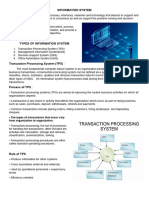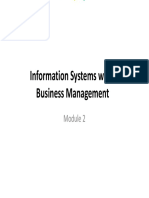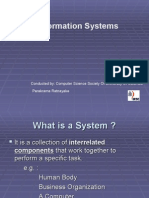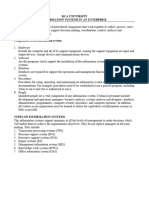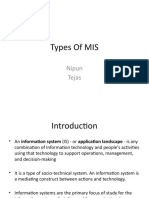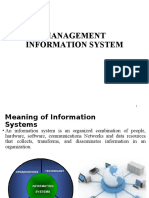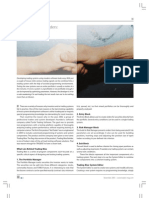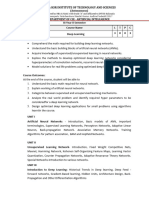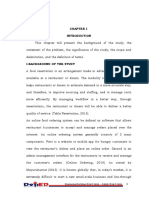0 ratings0% found this document useful (0 votes)
2 viewsChapter_2
Chapter_2
Uploaded by
backhaileupCopyright:
© All Rights Reserved
Available Formats
Download as PPTX, PDF, TXT or read online from Scribd
Chapter_2
Chapter_2
Uploaded by
backhaileup0 ratings0% found this document useful (0 votes)
2 views46 pagesCopyright
© © All Rights Reserved
Available Formats
PPTX, PDF, TXT or read online from Scribd
Share this document
Did you find this document useful?
Is this content inappropriate?
Copyright:
© All Rights Reserved
Available Formats
Download as PPTX, PDF, TXT or read online from Scribd
Download as pptx, pdf, or txt
0 ratings0% found this document useful (0 votes)
2 views46 pagesChapter_2
Chapter_2
Uploaded by
backhaileupCopyright:
© All Rights Reserved
Available Formats
Download as PPTX, PDF, TXT or read online from Scribd
Download as pptx, pdf, or txt
You are on page 1of 46
Chapter-2
TYPES OF INFORMATION SYSTEMS(SIS Types)
TYPES OF INFORMATION SYSTEMS
• The six components that must come together in order to produce an information
system are:
• Hardware: The term hardware refers to machinery. This category includes the
computer itself, which is often referred to as the central processing unit (CPU), and all
of its support equipment. Among the support, equipment are input and output
devices, storage devices and communications devices.
• Software: The term software refers to computer programs and the manuals (if any) that
support them. Computer programs are machine-readable instructions that direct the
circuitry within the hardware parts of the system to function in ways that produce
useful information from data. Programs are generally stored on some input/output
medium, often a disk or tape.
• Data: Data are facts that are used by programs to produce useful information. Like
programs, data are generally stored in machine-readable form on disk or tape until the
computer needs them.
Procedures: Procedures are the policies that govern the operation of a computer system.
"Procedures are to people what software is to hardware" is a common analogy that is used
to illustrate the role of procedures in a system.
People: Every system needs people if it is to be useful. Often the most overlooked element
of the system are the people, probably the component that most influence the success or
failure of information systems. This includes "not only the users, but those who operate and
service the computers, those who maintain the data, and those who support the network of
computers."
Feedback: it is another component of the IS, that defines that an IS may be provided with a
feedback (Although this component isn't necessary to function).
Data is the bridge between hardware and people. This means that the data we collect is
only data until we involve people. At that point, data is now information.
Types of Information Systems (MIS)
The types of information systems can be presented in the following way:
Types of Strategic Information Systems (SIS)
The analysis is based on the fact that the Strategic Information System (SIS) provides three
types of strategic information (environmental information, competitive information and
internal information).
Environmental information is used to analyze five types of external environmental factors
• technological factors
• economic factors
• social factors
• legal factors and international factors
Competitive information is used to analyze three essential elements
• competitors
• suppliers
• and customers
internal information is used to analyze four major organizational activities
• Financial activity,
• Human resources activity,
• Market activity and
• Production activity activity
1. Transaction Processing Systems
Transaction Processing System are operational-level systems at the bottom of the
pyramid.
• They are usually operated directly by shop floor workers or front-line staff, which
provide the key data required to support the management of operations.
• This data is usually obtained through the automated or semi-automated tracking
of low level activities and basic transactions.
• Functions of a TPS: TPS are ultimately little more than simple data processing
systems.
• Some examples of TPS: Payroll systems; Order processing systems; Reservation
systems; Stock control systems; Systems for payments and funds transfers;
• Salient Features: Produce information for other systems; Cross boundaries
(internal and external); Used by operational personnel + supervisory levels;
Efficiency oriented
2. Management Information Systems
• For historical reasons, many of the different types of Information Systems found in commercial
organizations are referred to as "Management Information Systems".
• However, within our pyramid model, Management Information Systems are management level
systems that are used by middle managers to help ensure the smooth running of the organization
in the short to medium term.
• The highly structured information provided by these systems allows managers to evaluate an
organization's performance by comparing current with previous outputs.
• Functions of a MIS: MIS are built on the data provided by the TPS
• Some examples of MIS: Sales management systems; Inventory control systems; Budgeting
systems; Management Reporting Systems (MRS); Personnel (HRM) systems;
• Salient Features: Based on internal information flows; Support relatively structured decisions;
Inflexible and have little analytical capacity; Used by lower and middle managerial levels; and
Deals with the past and present rather than the future; and Are efficiency oriented.
3. Decision Support Systems
A Decision Support System can be seen as knowledge based system, used by senior managers, which
facilitates the creation of knowledge and allow its integration into the organization.
• These systems are often used to analyze existing structured information and allow managers to
project the potential effects of their decisions into the future.
• Such systems are usually interactive and are used to solve ill structured problems. They offer
access to databases, analytical tools, allow "what if" simulations, and may support the exchange of
information within the organization.
Functions of a DSS: DSS manipulate and build upon the information from a MIS and/or TPS to
generate insights and new information.
• Some examples of DSS: Group Decision Support Systems (GDSS); Computer Supported
Cooperative work (CSCW); Logistics systems; Financial Planning systems; and Spreadsheet Models;
Salient features of DSS: Support ill- structured or semi-structured decisions; Have analytical and/or
modeling capacity; Used by more senior managerial levels; Are concerned with predicting the future;
and Are effectiveness oriented.
4. Executive Information
Systems
Executive Information Systems are strategic-level information systems
that are found at the top of the Pyramid.
• They help executives and senior managers analyze the environment in
which the organization operates, to identify long-term trends, and to
plan appropriate courses of action.
• The information in such systems is often weakly structured and comes
from both internal and external sources.
EIS cont…
Executive Information System are designed to be operated directly by executives
without the need for intermediaries and easily tailored to the preferences of the
individual using them.
Functions of an EIS: EIS organizes and presents data and information from both
external data sources and internal MIS or TPS in order to support and extend the
inherent capabilities of senior executives.
Some examples of EIS: Executive Information Systems tend to be highly
individualized and are often custom made for a particular client group; however, a
number of off-the-shelf EIS packages do exist and many enterprise level systems
offer a customizable EIS module.
The role of EIS: Are concerned with ease of use; Are concerned with predicting the
future;
• Are effectiveness oriented; Are highly flexible; Support unstructured decisions;
Use internal and external data sources; and Used only at the most senior
management levels.
Types of Information Systems Strategies
Operations support system
In a firm, data execution is performed by the user end, which is later processed to generate useful data products and services like
reports, which are utilized by different users. Such a strategy is called operation support.
The primary purpose of this system is to keep a check on transactions, operations, control, chain supply, and management.
• It also helps to facilitate internal and external talks, and it updates the central main database of the organization.
• The operation support system is further divided into three systems which are Transaction Processing System (TPS) , Process
Control System and Enterprise Collaboration System.
Firms require accurate data in a specific format to understand the decisions of the organizations.
MIS
Management support system strategy enables the effective decision and task operation process more manageable for the
managers.
• They are essentially divided into a different strategy like management, decision, accounting and expert information system.
• These systems facilitate and provide precise information and data to the manager for easy routines, decision-making processes.
• Decision support system which helps to solve particular issues related problems.
Key Takeaways
• Information needs vary according to managerial level (top, middle, or first-line).
• An IS, or information system, can be divided into two categories:
• Those that meet the needs of low-level managers
• Those that meet the needs of middle- and upper-level managers
• Low-level managers—those who run day-to-day operations and make routine decisions—use operations support
systems, which usually fall into three categories: transaction processing systems, process control systems, and
computer-aided design software.
• Most daily activities are recorded and processed by a transaction processing system, which receives input data and converts them
into output—information—intended for various users.
• Process control refers to the application of technology to monitor and control physical processes, such as food preparation. The
system depends on sensors to collect data for analysis by a computer programmed either to make adjustments or to signal an
operator.
• Technology can be used to design and make products. Computer-aided design (CAD) software, for instance, enables designers to
test computer models digitally before moving new products into the prototype stage.
• Mid- and upper-level managers may use one of four types of management support system to assist in decision-
making activities: management information systems, decision support systems, executive information systems, and
expert systems.
• A management information system extracts data from a database to compile reports, such as sales analyses, needed for making
routine decisions.
• A decision support system is an interactive system that collects and integrates data from multiple sources to assist in making non-
routine decisions.
• To develop plans and make major decisions, managers may gather relevant, timely, easily understood information through
an executive information system; an EIS provides ready access to strategic information that’s customized to their needs and
presented in a convenient format.
• An expert system mimics expert judgment by following sets of rules that experts would follow; it relies on artificial intelligence—the
science of developing computer systems that can mimic human behavior.
You might also like
- Management Information systems - MIS: Business strategy books, #4From EverandManagement Information systems - MIS: Business strategy books, #4No ratings yet
- Sage X3 - User Guide - HTG-Setting Up A Workflow For A Batch Task PDFDocument8 pagesSage X3 - User Guide - HTG-Setting Up A Workflow For A Batch Task PDFcaplusincNo ratings yet
- Types of Information Systems in An OrganizationDocument8 pagesTypes of Information Systems in An Organizationimmanjeri39No ratings yet
- Information SystemDocument9 pagesInformation Systemsakinayasin75No ratings yet
- Information Systems: Prepared By: Gopal PatelDocument23 pagesInformation Systems: Prepared By: Gopal Patelgopalmeb6368No ratings yet
- Information System PPTXDocument42 pagesInformation System PPTXTeferi GetaNo ratings yet
- Chapter 5 Is Types of Is 25pDocument26 pagesChapter 5 Is Types of Is 25pbelachewh8No ratings yet
- MIS Unit II Complete-ShareDocument42 pagesMIS Unit II Complete-Sharedeepshikhasingh4315No ratings yet
- The Main Kinds of Information Systems in Business Are Described Briefly BelowDocument11 pagesThe Main Kinds of Information Systems in Business Are Described Briefly BelowDrPallati SujendraNo ratings yet
- MIS Foundational ConceptsDocument22 pagesMIS Foundational Conceptssheenu117No ratings yet
- Management Information SystemDocument106 pagesManagement Information SystemAbdelrhman AhmedNo ratings yet
- Unit IDocument29 pagesUnit Imanishchavhan02No ratings yet
- Management Information SystemDocument98 pagesManagement Information SystemPranjit BhuyanNo ratings yet
- Information SystemDocument7 pagesInformation SystemChadury HaiderNo ratings yet
- Module - 2 - MIS - CSIT204Document47 pagesModule - 2 - MIS - CSIT204aakash sharmaNo ratings yet
- Structures of Information System in Origination and TypesDocument19 pagesStructures of Information System in Origination and TypesDegu DegaregNo ratings yet
- FUNDAMENTALS OF IT & ERP Module 2Document34 pagesFUNDAMENTALS OF IT & ERP Module 2rabit3690No ratings yet
- 5 UnitDocument16 pages5 UnitKeshab PalNo ratings yet
- DssDocument35 pagesDsshsrinivas_7No ratings yet
- CS - PPT 1 1Document63 pagesCS - PPT 1 1noreply.myworkspaceNo ratings yet
- Information SystemsDocument33 pagesInformation Systemsslishanadata100% (13)
- CBISDocument27 pagesCBISSamaria Liaqat100% (1)
- ITunit 2Document12 pagesITunit 2ShreestiNo ratings yet
- Mis Unit 1Document31 pagesMis Unit 1shreyamalpani4555No ratings yet
- MIS SolutionDocument19 pagesMIS Solutionmdarmaanmalik0078600No ratings yet
- MIS & Other SubsystemsDocument89 pagesMIS & Other SubsystemsDebi Mohapatra33% (3)
- CBISDocument6 pagesCBISNida HassanNo ratings yet
- Chapter 3Document22 pagesChapter 3garashi jumaNo ratings yet
- Is 217 - Deployment Maintenance & ServicesDocument18 pagesIs 217 - Deployment Maintenance & ServicesAllan IgbuhayNo ratings yet
- Information Systems: Definitions and ComponentsDocument20 pagesInformation Systems: Definitions and Componentssubhash221103No ratings yet
- CBIS (Computer Based Information System) : DataDocument7 pagesCBIS (Computer Based Information System) : Dataخالد ناهض نايف نجمNo ratings yet
- Unit 1Document7 pagesUnit 1shalini selvarajNo ratings yet
- MIS - Knowledge Management SystemDocument5 pagesMIS - Knowledge Management SystembudhNo ratings yet
- SM 58Document7 pagesSM 58Mouna ElNo ratings yet
- Managment Information SystemDocument64 pagesManagment Information SystemTech ProffesorNo ratings yet
- 01 - Introduction To IsDocument34 pages01 - Introduction To IsChee Lin YongNo ratings yet
- Introduction To System Analysis and Design (Slides)Document46 pagesIntroduction To System Analysis and Design (Slides)Sarkhel Jiskani100% (2)
- Types of System: by Ankita KishoreDocument12 pagesTypes of System: by Ankita KishoreAnviNo ratings yet
- Topic 7-8 Information Systems in An EnterpriseDocument19 pagesTopic 7-8 Information Systems in An EnterpriseBENSON NGARINo ratings yet
- New PPTX PresentationDocument9 pagesNew PPTX Presentationsagarratia42No ratings yet
- Information SystemDocument51 pagesInformation SystemVkNo ratings yet
- Module-2-Kinds of Information SystemsDocument12 pagesModule-2-Kinds of Information SystemsYogeshNo ratings yet
- Cyber Security Module 1Document4 pagesCyber Security Module 1silentnightNo ratings yet
- MispdfDocument22 pagesMispdfsonuNo ratings yet
- Types of MIS: Nipun TejasDocument15 pagesTypes of MIS: Nipun Tejastejaskapoor90No ratings yet
- Management Information SystemDocument45 pagesManagement Information SystemYt NoobNo ratings yet
- Unit 2 - Overview of Information SystemsDocument7 pagesUnit 2 - Overview of Information SystemsJason Jay MillerNo ratings yet
- Mis IntroDocument16 pagesMis Introrinku2012No ratings yet
- Umar Saeed Software Engineer University of GujratDocument13 pagesUmar Saeed Software Engineer University of GujratUbaid KhanzadaNo ratings yet
- Amity Business School: MBA, Semester - 3 Management of Software Projects Teena BaggaDocument55 pagesAmity Business School: MBA, Semester - 3 Management of Software Projects Teena BaggaAvi KoolNo ratings yet
- Operational Information SystemDocument19 pagesOperational Information SystemMeredith Clark0% (1)
- MIS Notes ConsolidatedDocument13 pagesMIS Notes ConsolidatedShivam SinghNo ratings yet
- What Is MIS? Intoduction & Definition: Management Information System ManagersDocument6 pagesWhat Is MIS? Intoduction & Definition: Management Information System ManagersSANDUN KAVINDANo ratings yet
- Bab 1Document57 pagesBab 1SYED AHMAD SHAUQI BIN SYED SHUHAIMINo ratings yet
- Management Information SystemDocument12 pagesManagement Information Systembadamirabari04No ratings yet
- Unit-1 Understanding MISDocument10 pagesUnit-1 Understanding MISsachinchauhanjiNo ratings yet
- Itam PPT 1Document35 pagesItam PPT 1Karunesh MathurNo ratings yet
- Untitled DocumentDocument8 pagesUntitled Documentasmaa01961No ratings yet
- Prof. Dakshata GadiyaDocument24 pagesProf. Dakshata GadiyaDakshata GadiyaNo ratings yet
- Prof. Dakshata GadiyaDocument24 pagesProf. Dakshata GadiyasekharburagohainNo ratings yet
- Zero To Mastery In Cybersecurity- Become Zero To Hero In Cybersecurity, This Cybersecurity Book Covers A-Z Cybersecurity Concepts, 2022 Latest EditionFrom EverandZero To Mastery In Cybersecurity- Become Zero To Hero In Cybersecurity, This Cybersecurity Book Covers A-Z Cybersecurity Concepts, 2022 Latest EditionNo ratings yet
- Resume UpdatedDocument2 pagesResume UpdatedAnonymous vT6ht4BWNo ratings yet
- IF4071 - Deep Learning LaboratoryDocument1 pageIF4071 - Deep Learning Laboratoryjinitha.ANo ratings yet
- Traders Review of Trading Blox SoftwareDocument3 pagesTraders Review of Trading Blox Softwarecffex100% (1)
- Alcohol Sensing Alert With Engine Locking ProjectDocument48 pagesAlcohol Sensing Alert With Engine Locking Projecturjashah06No ratings yet
- AI-based Condition Monitoring For Low Voltage MotorsDocument23 pagesAI-based Condition Monitoring For Low Voltage MotorsBryan OrtegaNo ratings yet
- Research Paper On Technology ManagementDocument8 pagesResearch Paper On Technology Managementmadywedykul2100% (1)
- SM12 - Lock ConceptDocument2 pagesSM12 - Lock ConceptPILLINAGARAJUNo ratings yet
- Hildear463 PDFDocument3 pagesHildear463 PDFJomar RicablancaNo ratings yet
- Ai 3-2 DLDocument2 pagesAi 3-2 DLSaiNo ratings yet
- Granting Read Permissions To Root Directory Best Practices and Alternative ApproachesDocument4 pagesGranting Read Permissions To Root Directory Best Practices and Alternative ApproachesGabriel DíazNo ratings yet
- How Netflix Uses Big Data To Drive Business Success - SmartData CollectiveDocument8 pagesHow Netflix Uses Big Data To Drive Business Success - SmartData Collectivevaria.varia4319100% (1)
- A Trajectory of Arti Ciality and New - KrippendorffDocument7 pagesA Trajectory of Arti Ciality and New - KrippendorffLoi AzulNo ratings yet
- Food Reservation SystemDocument44 pagesFood Reservation SystemArthan KyleNo ratings yet
- Funambol SyncML BookDocument29 pagesFunambol SyncML BooksimishuNo ratings yet
- Capstone Project ReportDocument50 pagesCapstone Project ReportRAHUL ASTICNo ratings yet
- FLIR K2 Thermal Imaging CameraDocument2 pagesFLIR K2 Thermal Imaging CameraForum PompieriiNo ratings yet
- Gmi Products Brochure DTS0779Document56 pagesGmi Products Brochure DTS0779Peyman AzizzadehNo ratings yet
- Advanced MBSD - NotesDocument737 pagesAdvanced MBSD - NotesTom KigeziNo ratings yet
- Advance Java NotesDocument32 pagesAdvance Java Notesdevillucifer2411No ratings yet
- Presentation of Cyber CafeDocument13 pagesPresentation of Cyber CafeNazmul Islam Khan Tutul67% (3)
- Question BankDocument10 pagesQuestion BankRohitNo ratings yet
- Online Food Ordering Management System ProjectDocument17 pagesOnline Food Ordering Management System ProjectRAJ ROUNAK0% (1)
- AZ 900 Questions - Part 9Document8 pagesAZ 900 Questions - Part 9Nguyen Tuan AnhNo ratings yet
- Solutions of RDBMSDocument64 pagesSolutions of RDBMSAkshay MehtaNo ratings yet
- I2v Quickstart GuideDocument7 pagesI2v Quickstart Guideshravan38No ratings yet
- Power Consumption ReportDocument23 pagesPower Consumption ReportTushar KarhaleNo ratings yet
- PowerApps - Performance and Optimization TipsDocument15 pagesPowerApps - Performance and Optimization Tipsjpereztmp100% (1)
- Insight Managed Wifi 6 Ax1800 Wireless Access PointsDocument8 pagesInsight Managed Wifi 6 Ax1800 Wireless Access PointsJc GehhackNo ratings yet
- Bullet Pixels 2: by Samurai CircuitsDocument3 pagesBullet Pixels 2: by Samurai CircuitsdinhanhminhqtNo ratings yet













